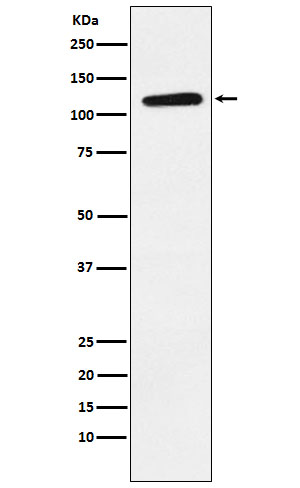产品名称
Eph receptor B1 (19N17) Rabbit Monoclonal Antibody
别名
ELK; NET; Hek6; EPHT2; EPHB1;
纯度
Affinity-chromatography
蛋白名称
ELK, EPHT2, HEK6, NET
存储缓冲液
Supplied in 50mM Tris-Glycine(pH 7.4), 0.15M NaCl, 40%Glycerol, 0.01% New type preservative N and 0.05% BSA.
Human Swissprot No.
P54762
免疫原
A synthetic peptide of human Eph receptor B1/NET
注意事项
Eph receptor B1 Antibody is for research use only and not for use in diagnostic or therapeutic procedures.
组织表达
Preferentially expressed in brain.
细胞定位
Cell membrane; Single-pass type I membrane protein Early endosome membrane. Cell projection, dendrite {ECO:0000250|UniProtKB:Q8CBF3}
功能
Receptor tyrosine kinase which binds promiscuously transmembrane ephrin-B family ligands residing on adjacent cells, leading to contact-dependent bidirectional signaling into neighboring cells. The signaling pathway downstream of the receptor is referred to as forward signaling while the signaling pathway downstream of the ephrin ligand is referred to as reverse signaling. Cognate/functional ephrin ligands for this receptor include EFNB1, EFNB2 and EFNB3. During nervous system development, regulates retinal axon guidance redirecting ipsilaterally ventrotemporal retinal ganglion cells axons at the optic chiasm midline. This probably requires repulsive interaction with EFNB2. In the adult nervous system together with EFNB3, regulates chemotaxis, proliferation and polarity of the hippocampus neural progenitors. In addition to its role in axon guidance plays also an important redundant role with other ephrin-B receptors in development and maturation of dendritic spines and synapse formation. May also regulate angiogenesis. More generally, may play a role in targeted cell migration and adhesion. Upon activation by EFNB1 and probably other ephrin-B ligands activates the MAPK/ERK and the JNK signaling cascades to regulate cell migration and adhesion respectively. Involved in the maintenance of the pool of satellite cells (muscle stem cells) by promoting their self-renewal and reducing their activation and differentiation (By similarity).

